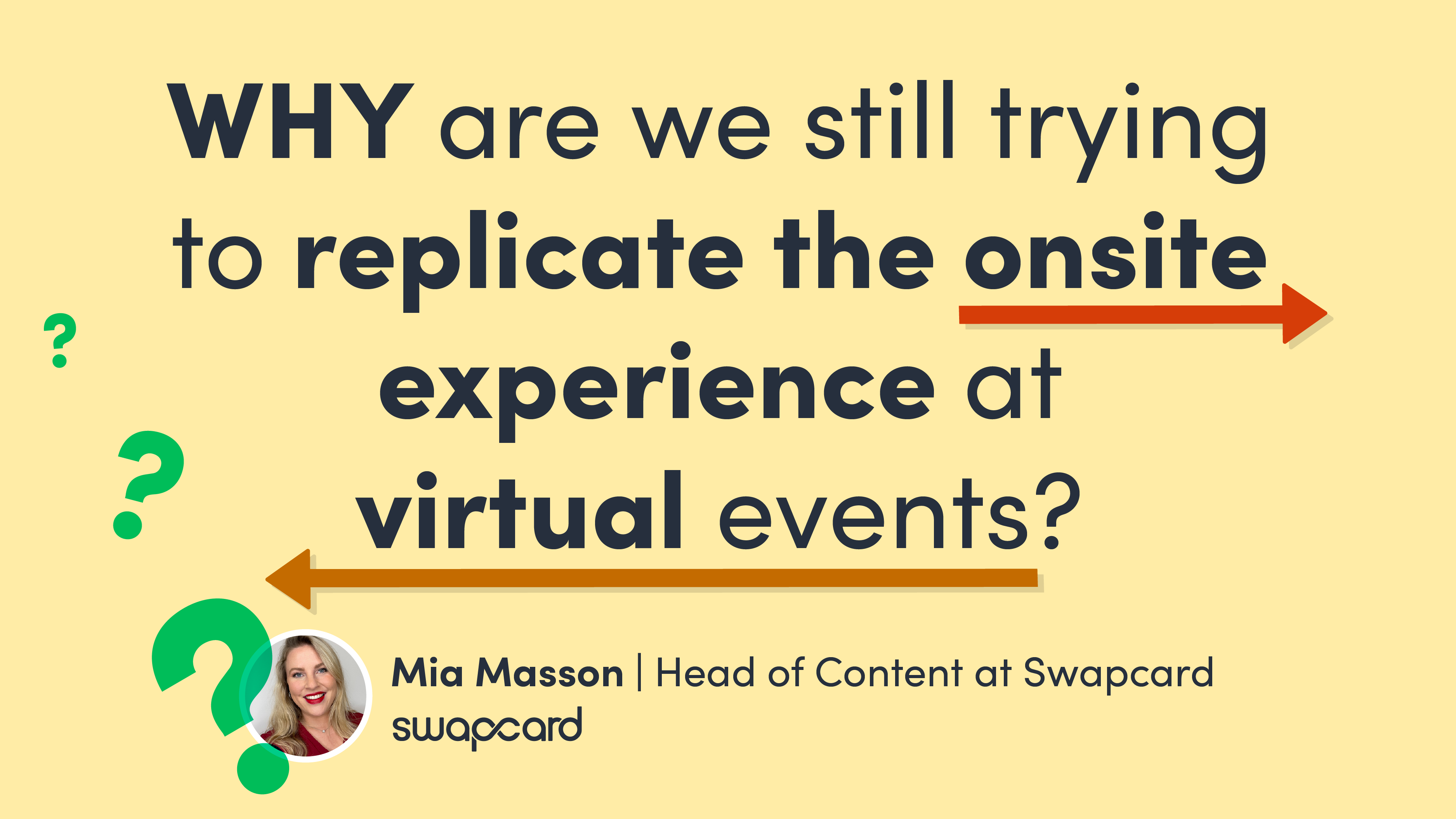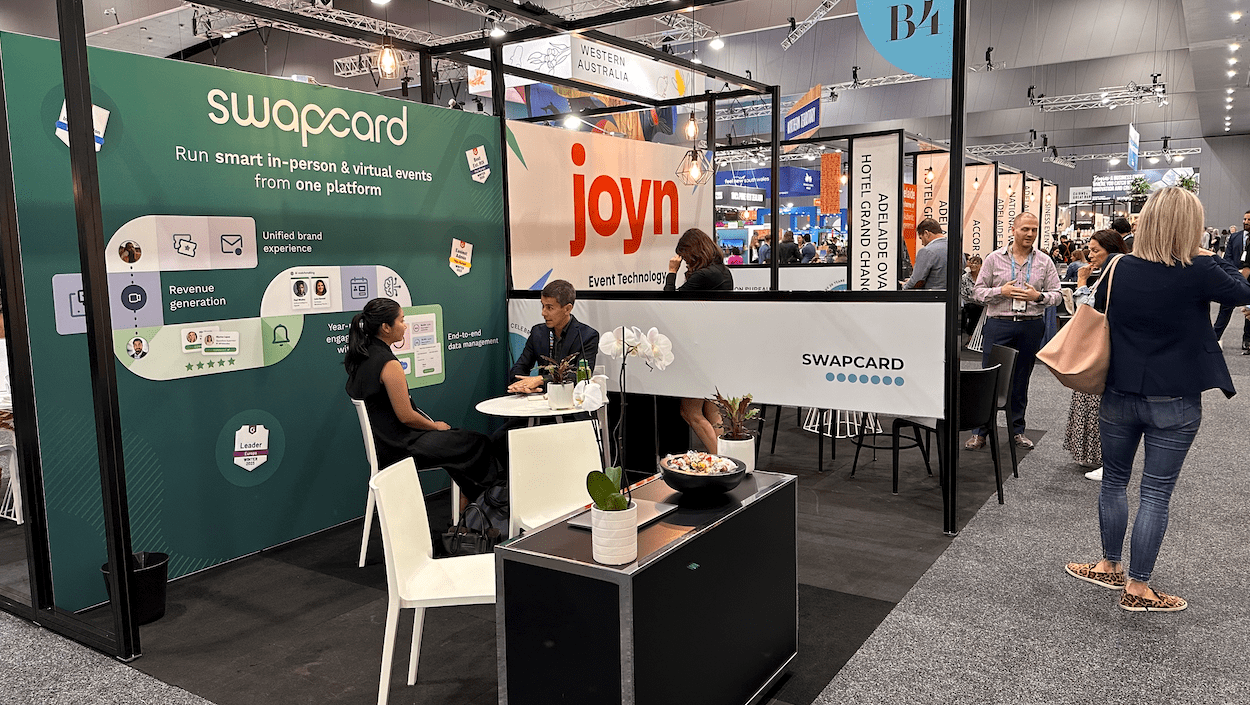The digital revolution in the events industry has been slow and fragmented, often hindered by budget constraints and a lack of expertise. Despite these challenges, a shift towards data-centric solutions is emerging, with the adoption of event management and analytics platforms becoming increasingly prevalent. Yet, many organizers are finding themselves struggling to keep up.
If you’re wondering what data points you should focus on at your onsite event, how to tackle data privacy hurdles, and use data from emerging technologies to boost exhibitor ROI, keep reading!
💡This article is a sneak peek of a recent panel discussion in which Godofroy des Francs, CPO & Co-founder at Swapcard sat down with industry experts Mark Maydon, Commercial Director at CrowdConnected, and Ross Sudentas, CEO of ExpoFP, to discuss how organizers can optimize their events through effective data utilization. Watch the full episode here.
Avoiding the Dreaded Data Overload at Onsite Events
At onsite events, the challenge isn't collecting more data but collecting the right data. Focusing on actionable insights can streamline decision-making and enhance outcomes. As Ross notes, "Less data is sometimes more. What we want is data that can lead to actionable results."
Mark echoes this sentiment, “We've seen time and time again, event organizers collecting data, but actually doing nothing with it because it isn't actionable. The thing to focus on is outcomes and not outputs because you can drown in outputs. But if you think about outcomes and the outcomes you're trying to drive, you'll think about the data that really is valuable to you.”
So, what’s the first step in figuring this out?
“I think a good place to start with is what problems you're trying to solve. What are you thinking about regarding the improvements you want to see? Or what did you need to tell the participants involved in the event? Then think about the data that might help drive that narrative.” — Mark Maydon
Once you’ve selected the metrics that align closely with your event goals and you know what you want to measure, you need to set about measuring it. The tools you use can make all the difference.
Godofroy des Francs, CPO & Co-founder at Swapcard talked about the importance of adopting a Centralized Data Management System (CMS) that allows organizers to streamline data collection and analysis. He also stresses the importance of opting for an intuitive platform that presents complex data in an understandable and actionable format,
“It's basic, but having a nice dashboard that shows the data as it comes in really helps with making fast and smart decisions without being overwhelmed with too much information.” — Godofroy de Francs

Onsite Metrics to Improve ROI
As improving exhibitor ROI is a core objective for all trade show organizers, we asked Mark and Ross to highlight some key onsite metrics that they can focus on. Here are the top three:
1. Behavioral Analytics
“If you think about running a large-scale website, you have metrics and understand exactly how people are navigating and moving through that digital environment, where they're spending time, and what they're consuming. You can think about a physical event through the same lenses, which might enable you to understand how well the event ecosystem is working.” — Mark Maydon
Attendees perform a variety of actions within the event space (both in-person and online). Organizers can look at how long attendees stay in certain areas, whether they utilize navigation and wayfinding technologies to find exhibitor booths, their movement patterns (footfall analysis), and which exhibits or sessions attract the most interest.
By tracking which areas are most popular and when they are frequented, organizers can optimize space usage and scheduling for targeted advertising and booth placements, directly enhancing exhibitor visibility and engagement. This strategic placement ensures that exhibitors gain maximum exposure to the right audience, directly contributing to increased ROI.
“For example, using one of the sponsorship opportunities on the ExpoFP floor plan, like displaying a logo of the company in the booth or making a listing feature that allows it to show up more often in searches, will roughly increase your viewership. That makes [reinvestment] decisions for exhibitors easier when they clearly see the benefit and it's proven by data.” — Ross Sudentas
While Ross talks about how behavioral analytics can be used to upsell features and tools to exhibitors, the opportunities are limitless. By understanding attendee patterns and preferences, organizers can tailor marketing campaigns, customize event content, and improve overall user experience.
This data also supports predictive modeling, allowing for better forecasting of future events and attendee behaviors. Plus, the insights gathered can guide the layout design of the event space to improve flow and accessibility, making sure high-interest areas are easy to get to, increasing engagement and satisfaction.
Overall, this approach not only improves the attendee experience but also boosts exhibitor satisfaction and ROI.
2. Engagement Metrics
You can use multiple metrics to determine whether attendees are successfully finding what they need and engaging effectively at your event, one of which is engagement — measuring the quality and quantity of interactions that occur between participants.
Here are some examples:
- Scheduled Meeting Analytics: Analyze the number, duration, and outcomes of scheduled meetings to assess the networking platform's effectiveness. A high volume of lengthy meetings often indicates that attendees are making meaningful connections, which increases potential ROI.
- Networking Engagement: Track how often attendees bookmark virtual exhibitor booths or send connection requests. This data helps identify which features or exhibitors are drawing the most interest and fostering active engagement.
- Session Interaction: Monitor how attendees interact with sessions through technology usage. This includes adoption rates of mobile apps, utilization of interactive floor plans, and engagement with virtual booths. High usage rates and interactive session participation are strong indicators of attendee engagement and satisfaction.
3. Attendee Satisfaction Metrics
“I recently came across a really insightful report from January this year from Freeman Reports (Attendee Intent and Behavior, 2024), and they were measuring the attendee intent and behavior in B2B events. The key observation was that attendees' priorities must drive results. So, in other words, if you want to be an exhibitor and sponsor to succeed, you have to focus on helping your attendees find what they are looking for and connect with the right attendees and the right exhibitor. A better attendee experience ultimately leads to a higher exhibitor ROI.” — Godofroy de Francs
The most common way of measuring attendee satisfaction has typically been through attendee surveys. However, you can get more actionable insight if you go directly to qualitative event data.
Mark talks about how recently mobile app uptake at large-scale events has been driven by blue dot navigation, which indicates how important it is for attendees to find what they came for in the limited time they have.
“If you have very high app uptake and very good use of your wayfinding solution, your map and your indoor positioning, your blue dot navigation, that tells you that you are genuinely solving a problem.” — Mark Maydon
By understanding the areas and features that attract the most attendee interaction, organizers can offer targeted opportunities for exhibitors to increase their visibility in these hotspots. This could include premium booth placements, sponsored sessions, or digital ads within apps.
By focusing on both qualitative and quantitative measurements of attendee satisfaction, organizers can accurately gauge how well the event meets the needs of both attendees and exhibitors, ultimately guiding improvements for future events and boosting overall ROI.

Navigating Data Privacy
When it comes to collecting and utilizing attendee data, data protection regulations add a layer of complexity. As event organizers, you must ensure that all data collection and processing practices comply with GDPR and other data protection regulations.
To navigate these complexities effectively, focusing on the value exchange—where attendees see clear benefits from sharing their data—can significantly alleviate privacy concerns and reinforce trust.
“We were involved in an event just a week ago in the US, which had 70 percent app penetration. And over 50 percent of people attending were sharing their data because they were using the navigation feature in the app. That's very valuable data. But it was a clear value exchange. They were getting some really fantastic functionality that enhanced their event experience and made it easy for them to do what they needed to do.” — Mark Maydon
Focusing on a clear value exchange is an excellent way for organizers to collect and use attendee data in a way that builds trust and transparency while ensuring they are compliant with local or international data regulations.
💡Find out how Swapcard handles data safety here.

The Future of Event Tech for Onsite Data
Keep an eye on the future because AI and emerging tech are set to transform event data collection and use in some big ways.
Here are some tips to help you build data-driven events that are future-proof:
- Integrate AI to Analyze Data: Use AI-powered analytics to understand attendee behavior and preferences in real time. This can help you make on-the-fly adjustments to schedules, layouts, and content, ensuring your event resonates with attendees' current interests.
- Personalize Attendee Experiences: Implement systems that use data to deliver personalized recommendations to attendees. From suggesting sessions to recommending people to meet, such personal touches can greatly enhance the attendee experience and satisfaction.
- Upgrade to Advanced Navigation Tools: Invest in wayfinding solutions like blue dot navigation that not only guide attendees efficiently but also gather crucial data on traffic patterns and popular spots. This information helps optimize booth placement and promotional strategies, directly enhancing exhibitor visibility and ROI by driving more targeted attendee traffic.
💡Look for an event platform that integrates seamlessly with these technologies, offering robust analytics capabilities and user-friendly features.
Summary
When it comes to being data-driven, remember, less in more. The key lies in prioritizing actionable data that can lead to tangible improvements and decisions and looking at data holistically.
“You should see what it gives to you, but then you need to combine it with a real understanding. Just, plain conversations with attendees, exhibitors, their satisfaction scores and combine it in some holistic approach.” — Ross Sudentas
“It's a kind of balanced approach, and you may need to put together different pieces of information that you've gleaned from different sources in order to understand, does the narrative that you're adhering to is true. What's important is tying this back to the goals of the event and measuring things that again, tell you how successful you've been against those goals.” — Mark Maydon
By adopting these cutting-edge tools and approaches, you can harness the power of data to create unforgettable experiences that not only attract attendees year after year but also optimize operational efficiencies and exhibitor ROI.
.png)
.png?width=1520&height=618&name=Cover%20-%20IMG%2BText%20(20).png)


.png)






